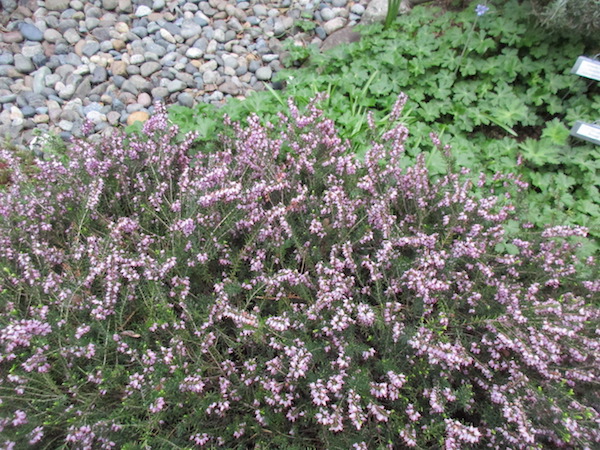Plant of the Month: April 2018
|
| Heaths and Heather |
ERICACEÆ ; Heath Family
|
| For decades, I have been uninformed about heaths and heather, and yet have been forced to learn more about them because both Calluna and Erica are included in my forthcoming edible houseplants book. |
These two genera are of great importance in the gardening realm. Also, they have much recorded usefulness and lore. My brief article shares but a basic introduction. Entire books exist on these fine plants.
|
| Calluna vulgaris (L.) Hull |
| Native in Eurasia, on acid, sandy soil, such as heaths, misty moors, rocky places, and bogs, is the compact shrub called Calluna vulgaris. It is the only species in its genus. Its English names include: Common Heather, Scottish Heather, He Heath, and Ling. A cold-hardy evergreen shrub, it is usually 3 feet high or less, and always has tiny leaves. The flowers are white to pink or dark purple, a quarter-inch long. They appear from July into November. |
| It is especially beloved in Scotland, "land of the brown heath and shaggy wood, land of the mountain and the flood." Highlanders slept on heather mattresses, thatched their roofs with it, and cooked by burning peat made from it. Brooms were made from its branches. Heather tea, mead and ale was brewed using its flowering tops. |
| Away from Scotland, in Bosnia the flowers have been used as a spice, and in Estonia, Sweden, Poland and doubtless elsewhere the seeds were added to bread in times of scarcity. |
| Hundreds of cultivars of diverse foliage color, plant size and fowering color and time, exist. |
The lovely illustration is from Flora Danica (1761 - 1883).
|

Calluna vulgaris from Flora Danica
|
| Erica spp. |
As for genus Erica, it is very large, with around 860 species. Most grow in South Africa. All are evergreen shrubs (or small trees rarely); they are notably hard-wooded. Many species tolerate lime soils unlike Calluna vulgaris; but some must have acid soils. Some are ulta cold-hardy, most are cold-tender. The leaves are linear, alternate, opposite or whorled in 3s, 4s or 5s. Flowers are tiny bells or urns, often profuse and showy. Regarding fragrance, Roy Genders reported: "Though the foliage of all the heathers has that invigorating tang which scents the moorland air for miles around, few species bear scented flowers."
|
| Erica arborea L. |
The Tree Heath or Giant Heath, is native in S Europe, Africa the Canary Islands and Asia Minor. Its wood is called briar root and used to make tobacco pipes. The flowers are scented of honey, are white, and appear from March into May. It has been recorded as tall as 49 feet, with trunks over 2 feet thick, with shreddy bark. Cultivated in the British Isles since 1658, one planted in 1894 in the Isles of Scilly, measured by 2006: 26 feet tall, its trunk almost a foot thick. My photo shows a Seattle Pacific University specimen in full bloom on April 29th 1989 --the next winter hurt it badly.
|

Erica arborea ; photo by ALJ
|
| Erica carnea L. |
Winter or Spring Heath. Mountain, Snow or Pink Moor Heath. Winter-flowering or Snow Heather. This is native to European mountains and Morocco. It grows low and spreads widely rather than being the least bit upright. In Seattle, it is the species most commonly seen. The leaves are glossy, blunt needeles, held in 4s on the twigs, and are from a quarter inch to half an inch long. The flowers appear between November and April, are tiny but borne by the millions and beloved by bees. They can be scented. They are rosy-red, pink, or white --hundreds of cultivars and hybrids exist. The two photos show one in my garden, blooming this month.
|

Erica carnea ; photo by ALJ
|

Erica carnea ; photo by ALJ
|
| Genus Erica has not been ingested by people to the same extent as its cousin Calluna. Several S African species have had their nectar sucked by people. A vague reference exists on the leaves and flowers of Erica Massonii being eaten. |
As for indoors cultivation, both genera are best outside, or at leat in a cool conservatory. If all you have is a house or apartment, a window box is better than keeping the plants inside. If it is in a house in a pot, it needs ample humidity, light and coolness to remain healthy. Whether cultivated inside or out, pruning after flowering is a good practice to maintain size and promote the best floral displays.
Back |
|
|

